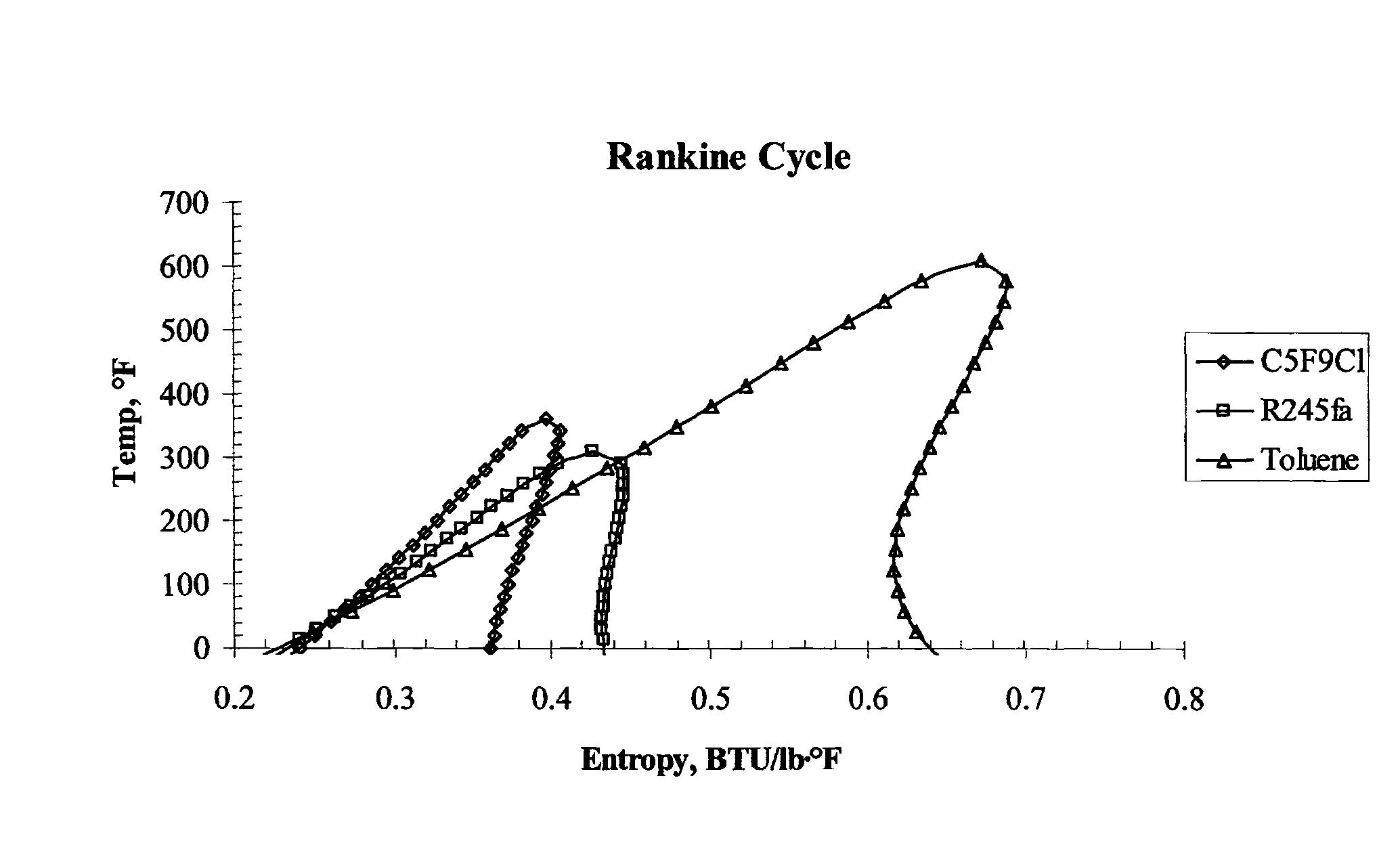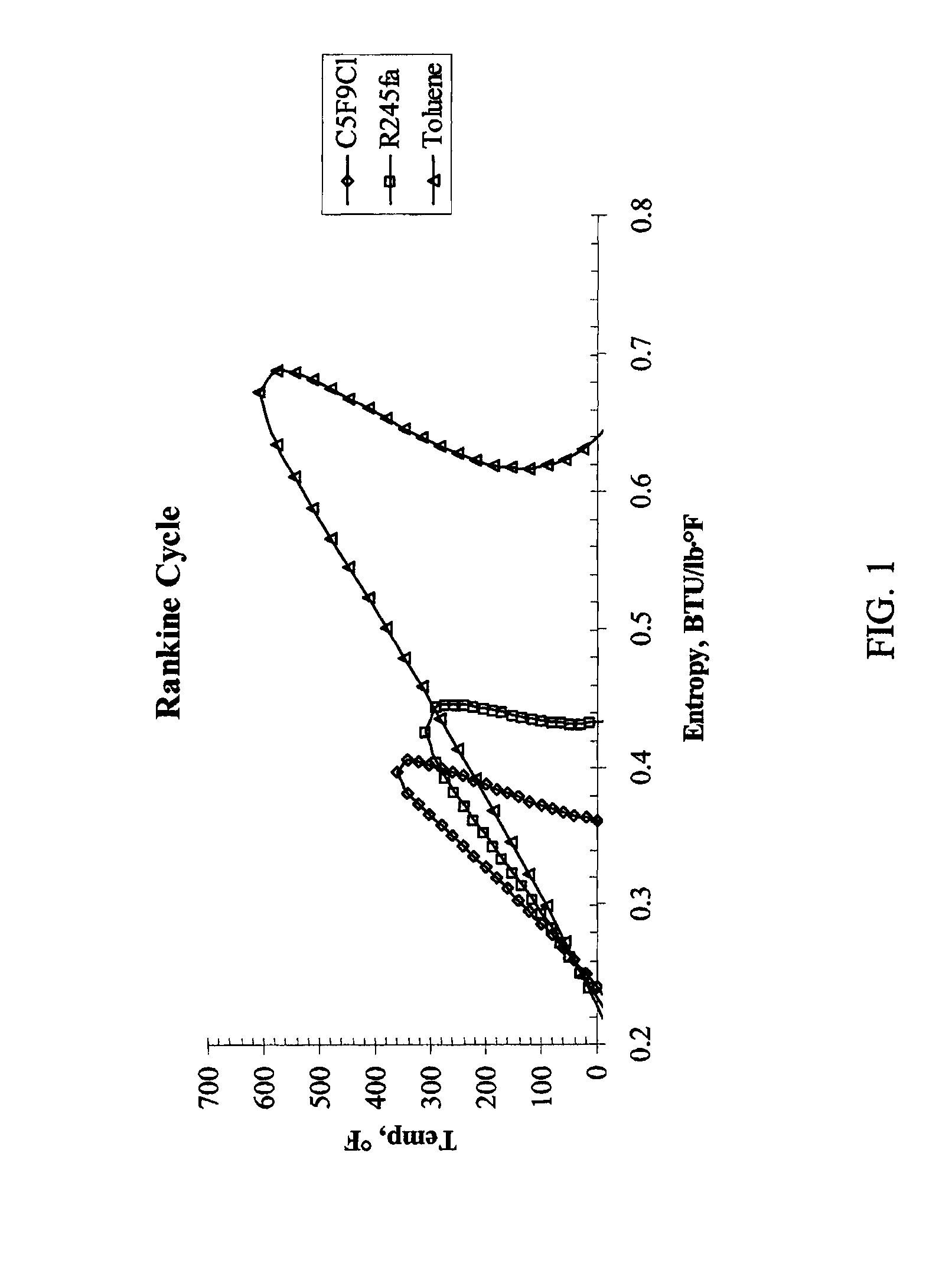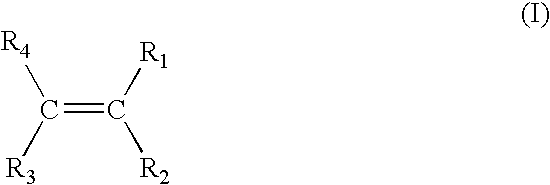Chloro- And Bromo-Fluoro Olefin Compounds Useful As Organic Rankine Cycle Working Fluids
a technology of fluorofluoroolefins and which is applied in the field of organic rankine cycle working fluids, can solve the problems of reducing the efficiency and work output of the cycle, cfcs and hcfcs have been shown to be harmful to the atmospheric ozone layer of the planet, and the flammability of toluene,
- Summary
- Abstract
- Description
- Claims
- Application Information
AI Technical Summary
Benefits of technology
Problems solved by technology
Method used
Image
Examples
example 1
[0040]When ranking organic working fluids for their ability to deliver an efficient Rankine cycle, the higher the critical temperature, the more efficient the cycle that can be derived. This is because the evaporator temperatures can more closely approach higher temperature heat sources. Organic working fluids for Rankine cycle (sometimes referred to as power cycle) applications are employed when source temperatures are moderate to low in thermal quality. At high temperatures, water is a very efficient working fluid; however, at moderate to low temperatures, the thermodynamics of water no longer are favorable.
[0041]FIG. 1 shows a plot of the temperature-entropy diagrams for HFC-245fa (comparative), an isomeric mixture of C5F9Cl compounds in accordance with the present invention, and toluene (comparative). Both HFC-245fa and toluene are used commercially as organic Rankine cycle working fluids. Based on the area swept out by the domes, it can be concluded that the Rankine cycle effic...
example 2
[0044]CF3CF═CFCF2CF2Cl and CF3CCl═CFCF2CF3 were made by reacting hexafluoropropene and chlorotrifluoroethylene in the presence of antimony pentafluoride. These isomers co-distill at a boiling point range 52-53° C.
2. Procedure
[0045]To a clean, dry Parr reactor / autoclave was added SbF5 (40 g, 0.16 mol), partially evacuated and sealed. The Parr Reactor was cooled to −30 to −35° C., evacuated and CF3CF═CF2 (128 g, 0.85 mol) and CF2═CFCl (92 g, 0.78 mol) were condensed, sequentially. The reactor was then sealed, gradually brought to room temperature (−25° C.) with stirring and maintained at this temperature for 16 hours; the pressure in the reactor dropped from 80 psi to 40 psi over this period. More volatile materials including any unreacted starting compounds in the reactor was vented through a cold trap (ice+salt) (20 g product was condensed in the trap). The remaining product in the Parr Reactor was collected into a cooled (dry ice) metal cylinder by heating the Parr reactor from RT ...
example 3
[0047]This example illustrates that the chloro-fluoro olefins of the invention, the C5F9Cl isomers and the HCFO-1233zd isomers, are useful as organic Rankine cycle working fluids.
[0048]The effectiveness of various working fluids in an organic Rankine cycle is compared by following the procedure outlined in Smith, J. M. et al., Introduction to Chemical Engineering Thermodynamics; McGraw-Hill (1996). The organic Rankine cycle calculations were made using the following conditions: pump efficiency of 75%, expander efficiency of 80%, boiler temperature of 130° C., condenser temperature of 45° C. and 1000 W of heat supplied to the boiler. Performance of various refrigerants is given in Table 1. Commercially available fluids including hydrofluorocarbons such as HFC-245fa (available from Honeywell), HFC-365mfc (available from Solvay), HFC-4310mee (available from DuPont) and the hydrofluoroether HFE-7100 (available from 3M) are included in the comparison. The thermal efficiency of HCFO-1233z...
PUM
| Property | Measurement | Unit |
|---|---|---|
| Capacitance | aaaaa | aaaaa |
| Fraction | aaaaa | aaaaa |
| Fraction | aaaaa | aaaaa |
Abstract
Description
Claims
Application Information
 Login to View More
Login to View More - R&D
- Intellectual Property
- Life Sciences
- Materials
- Tech Scout
- Unparalleled Data Quality
- Higher Quality Content
- 60% Fewer Hallucinations
Browse by: Latest US Patents, China's latest patents, Technical Efficacy Thesaurus, Application Domain, Technology Topic, Popular Technical Reports.
© 2025 PatSnap. All rights reserved.Legal|Privacy policy|Modern Slavery Act Transparency Statement|Sitemap|About US| Contact US: help@patsnap.com



